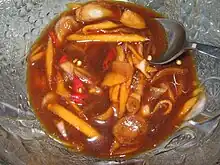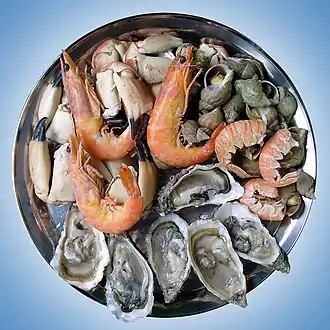 Prahok wrapped in banana leaves and grilled and served with fresh green vegetables and steamed rice. | |||||||
| Alternative names | prahoc, prohok, prohoc | ||||||
|---|---|---|---|---|---|---|---|
| Place of origin | Cambodia | ||||||
| Region or state | Southeast Asia | ||||||
| Associated cuisine | Cambodia | ||||||
| Main ingredients | fermented fish | ||||||
| 125 kcal (523 kJ) | |||||||
| |||||||
| Similar dishes | ngapi, bagoong, pla ra, padaek | ||||||
Prahok (/ˈprɑːhʊk/; Khmer: ប្រហុក, romanized: prâhŏk, IPA: [prɑːhok]) is a salted and fermented fish paste (usually of snakeheads) used in Cambodian cuisine as a seasoning or a condiment. It originated as a way of preserving fish during the months when fresh fish was not available in abundant supply. Because of its saltiness and strong flavor, it was used as an addition to many meals in Cambodian cuisine, such as soups and sauces. A Cambodian saying goes, "No prahok, no salt", referring to a dish that is of poor flavor or bland thus highlighting its essentiality in Cambodian cuisine.
Prahok has a strong and distinct odor reminiscent of Limburger or ripe Camembert,[1] which has earned it the nickname "Cambodian cheese".[2][3] Prahok is usually eaten as a main course with white rice and vegetables such as yardlong beans, cucumbers, winged beans and a variety of eggplants.
Prahok is sometimes distributed as a donation to victims of flood or drought by charities and other organizations.
Varieties and production
Prahok is made with various fish and methods of fermentation. Fish used include snakeheads (Channa spp.) and moonlight gourami (Trichogaster microlepis).
Prahok is obtained by crushing or grinding fresh fish after de-scaling, gutting and cleaning them. After the fish is crushed, it is left in the sun for a full day, then salted. The prahok is fermented in large clay jars covered with a lid made of woven bamboo strips. Afterwards, the prahok can be eaten just after 20 days of fermentation, but the best quality prahok is left to ferment for up to three years.
Prahok dishes

Prahok can be prepared and served in several different ways. Below are dishes where prahok is the main component.
Sautéed prahok
Prahok chien (ប្រហុកចៀន [prɑːhok ciən]) It is usually mixed with meat (usually beef or pork) and chilli peppers. It can also be eaten as a dip, accompanied by vegetables like cucumbers or eggplants, and rice.
Covered prahok
Prahok kab (ប្រហុកកប់ [prɑːhok kɑp]) or prahok ang (ប្រហុកអាំង [prɑːhok ʔaŋ]), types of prahok that are covered with banana leaves and left to cook under pieces of rock beneath a fire or over the coals.
Raw prahok
Prahok chhau (ប្រហុកឆៅ [prɑːhok cʰaw]) is a type of prahok can be used to make a paste with lemon grass, lime juice, fresh peppers, and eggplant eaten with (usually cooked rare) beef steak. Also, this is the type of prahok preferably used as a dipping paste for vegetables and fruits.
See also
- Bagoong – Type of Philippine condiment, Filipino fish paste
- Budu – Fish sauce originating from east coast of Peninsular Malaysia
- Burong isda – Filipino dish of rice and pickled fish
- Conpoy – Cantonese dried scallop
- Fish sauce – Condiment made from fish
- List of fish sauces
- Mam nem – Condiment
- Narezushi – Japanese dish of vinegared rice and usually seafood
- Ngapi – Seafood paste used in Burmese cuisine, Burmese fish paste
- Padaek – Traditional Lao condiment made from pickled or fermented fish that has been cured
- Pla ra – Southeast Asian fermented fish seasoning
- Saeu-jeot – Salted and fermented small shrimp in Korean cuisine
- Shrimp paste – Fermented condiment
- Kaeng tai pla – Southern Thai curry, made with a salty sauce made from fermented fish entrails
References
- ↑ De Monteiro, Longteine; Neustadt, Katherine (1998). The Elephant Walk Cookbook: Cambodian Cuisine from the Nationally Acclaimed Restaurant. Houghton Mifflin Harcourt. p. 301. ISBN 0395892538.
Its smell has earned it the nickname "Cambodian cheese" in The Elephant Walk kitchen, and its odor is reminiscent of Limburger or ripe Camembert.
- ↑ "Prahok, the Cambodian cheese". Lily's Secret Garden. 16 November 2019. Retrieved 12 November 2020.
- ↑ Higginbottom, Justin (22 November 2018). "Rotting Fish Odor — What's Not to Love About This Spicy Cambodian Paste?". OZY. Retrieved 12 November 2020.
External links
- Ly Vanna and Moul Jet (March 2002). The Story of Prahok. Leisure Cambodia (Volume 2, No. 3)
- Suy Se (January 19, 2007). Got fish? It's Prahok season in Cambodia. ThingsAsian

